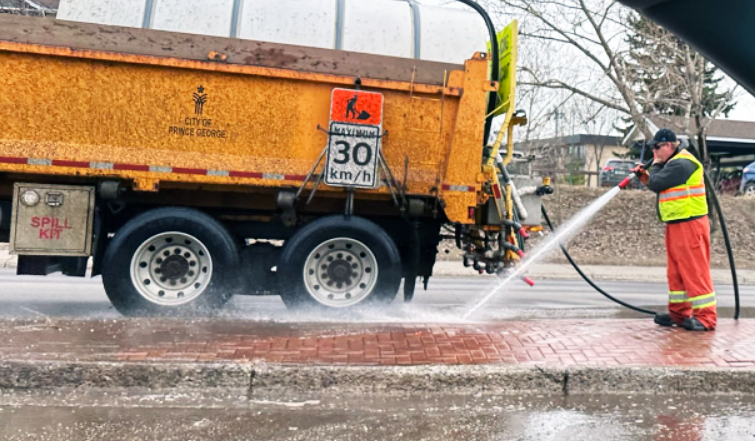Potholes and missing lane markers on city streets.
If you took a poll of Prince George drivers’ complaints about the state our road network, those two issues would no doubt top the list.
Jordan Wiseman, the city's manager of roads and fleet, knows the state of our roads is far from perfect, but it’s much better than it used to be.
“In 2015 we filled 20,000 potholes from roughly 1,500 requests about potholes, last year we did approximately 2,500 potholes with 960 requests,” said Jordan.
“It’s quite a dramatic decrease and from my standpoint that’s attributed to the investment in capital paving, but we still have a lot of work to do. Winters have been favourable and the fact we have two dedicated pothole trucks actually helps us get out there and deal with those problem spots when they arrive.”
The pothole trucks are equipped with a hopper that holds three tonnes of hot-mix paving material and once the asphalt plants open in mid-April those trucks will be on the case, dealing with calls that come in from citizens through the 3-1-1 hotline.
So far the city has filled 75 potholes from 63 requests.
The early spring weather has given city road maintenance crews the jump on street sweeping operations and we’re probably a few weeks ahead of getting that job done compared to last year, when spring was slow to arrive.
“It usually takes about eight weeks, if the weather plays fair to us and we can stay above zero during the day, which it looks like it’s going to be,” said Wiseman. “A little bit of rain is helpful because it keeps the dust down and we don’t have to use the water trucks as much.”
When the city conducts road sweeping operations a water truck is deployed to wet the road surface before the street sweepers come by to pick up the traction material and other debris. The water limits the dust that would otherwise get kicked up into the atmosphere. That could become even more problematic in Prince George because much of the city is in a bowl surrounded by hills where stagnant air tends to linger.
The city has roughly 1,475 lane kilometres of roads and close to 210 km of sidewalks to clean.
Right now the city has a workforce of 55 on morning, afternoon and evening shifts to get road debris removed from streets, sidewalks and boulevards. The sooner the catch basins and gutters are cleaned to prepare for rapid snow melting, the quicker the city can get to potholes, line-painting and resurfacing projects.
“Probably by the end of the week we’ll have all the sidewalks swept off and they still require flushing but the flusher trucks are close behind within a couple of days,” said Wiseman.
“We just started loader-brooming Ospika (Boulevard) two days ago and also we’re downtown, so we should have downtown picked up by the end of next week.”
Parking is restricted in residential areas from 8 a.m.-6 p.m.Parked cars that are impeding sweeping operations on any city street will be ticketed and/or towed.
While there weren’t as many heavy snowfalls (only three dumps this winter were Priority 3 snow events, greater than 12 centimetres) and fewer loads of fractured rock were required, Wiseman said the freeze-thaw cycles and small snowfalls proved problematic for city crews.
“The traffic gets on it and the temperature’s just right so it packs to compact snow, which would obviously require more traction material for safety reasons,” Wiseman said. “We definitely used less, but not that much less because those little snowfalls cause problems.”
Usually this time of year there’s a big mountain of snow where it gets dumped throughout the winter off 15th Avenue near Tabor Boulevard. This year it’s only a small pile, which reflects the reduced snowfalls the city has experienced this winter and spring.
Since the federal government enacted new environmental standards and banned oil-based paint in 2010, Prince George has been using water-based latex paint to mark road surfaces. The problem is the paint begins to fade after only a few months and it wears away even more rapidly in the winter months when there’s more grit and chlorides on the roads and plow blades scrape away snow. Until the line-painters get rolled out and those lines are repainted sometime this summer, motorists will be guessing where the lanes should be divided.
“Oil-based is considered a high VOC (Volatile Organic Compounds) paint and we’re bound by federal regulations but we’re always looking for a better alternative,” said Wiseman.
Wiseman said the city has experimented with thermoplastic (hot melt) road marking paint, which is 12 times more expensive than sprayed latex.
“Thermo is normally used on high-speed, high-volume areas, so crosswalks, intersection lines, things like that, and we do have a few posts where we’re testing that but we try to stay within the confines of our budget,” he said.
“On our main arterials like 15th Avenue where we can see 5,000 to 7,000 cars a day, we get a season out of (road markings). In residential areas that don’t see nearly as much mechanical snow removals, those lines stay a little bit longer. I’ve just accepted that this is our reality.”

.png;w=120;h=80;mode=crop)

